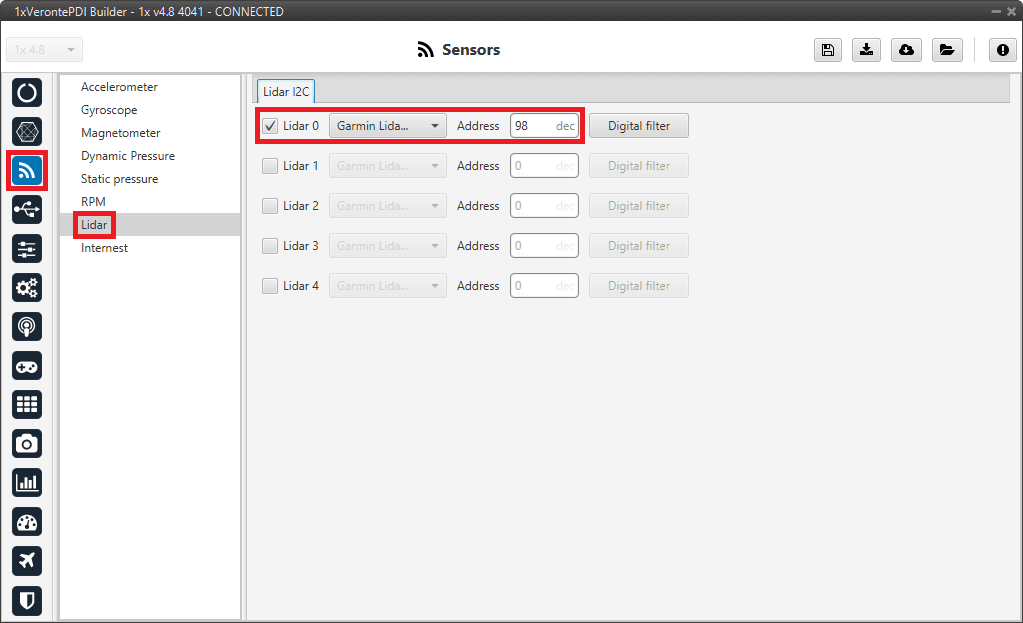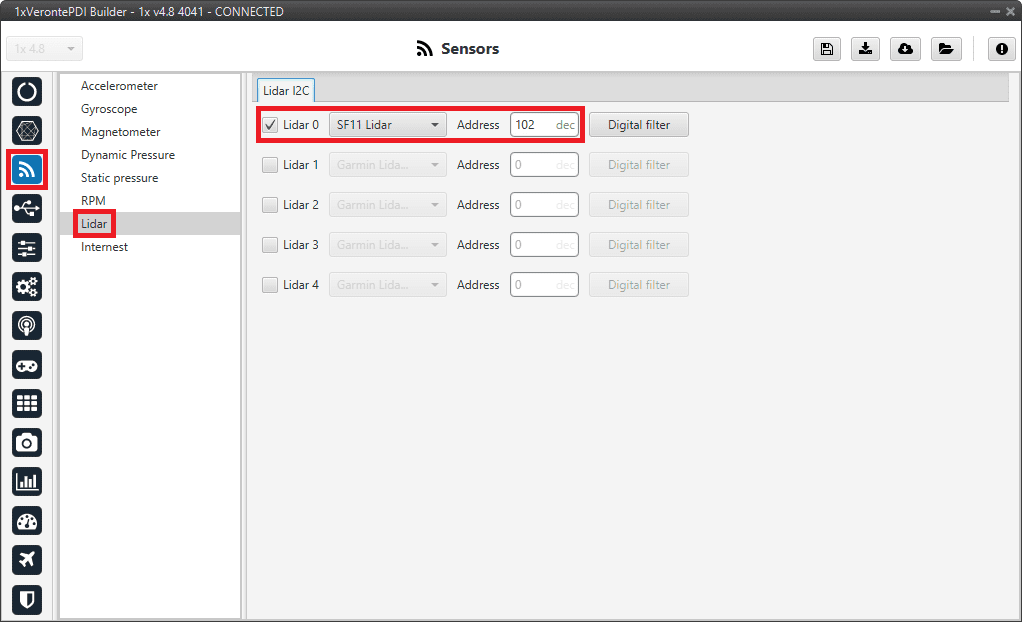Altimeters
Lidar
The integration between Veronte Autopilot 1x and a lidar is performed using a variety of interfaces depending on the lidar device. The most common interfaces are I2C or analog although serial or CAN bus can also be used if the lidar is compatible.
ADC lidar
An ADC lidar changes the voltage depending on the measured distance and therefore the connection to the Autopilot 1x is made using the ADC pins (see Pinout - Hardware Installation section of the 1x Hardware Manual).
Once connected to Autopilot 1x, the value can be monitored in 1x PDI Builder by using the variables ADC0 to ADC4.
Note
For pin ANALOG_0 the correspondent ADC variable in 1x PDI Builder is ADC0, for ANALOG_1 is ADC1 and so on.
-
Go to Connections menu ADC 0 panel (This is only an example, the user must select the ADC pin where the signal is connected).
Click on 'Create new program':

ADC lidar - Create ADC program -
Go to Block programs menu.
Configure the following operation (for more information about blocks, see Block Programs section of this manual):

ADC lidar - Lidar operation
After implementing the operation the variable Lidar 1 Distance will represent the distance measured by the lidar.
Note
As Autopilot 4x can read up to 36 V per each ADC, the value of the ADC program must be changed to if applicable.
I2C lidar
I2C lidars are configured slightly differently.
Connect the lidar following the pinout provided by the manufacturer and connect it to the Veronte Autopilot 1x I2C bus following the Pinout - Hardware Installation section of the 1x Hardware Manual.
In this case it is not needed to transform the lidar readings, the readings will be reported directly in the selected lidar distance variable.
Go to Sensors menu Lidar panel.
- Enable Lidar 0
- Select the desired Lidar from the drop-down menu
- Set the I2C address
More information on the available lidar options can be found in the Lidar - Sensors section of this manual.

Warning
I2C address will be different for different devices make sure to define it properly by checking the manufacturer documentation.
Lidar Garmin Lite v3
Once the device hardware installation explained in the Lidar Garmin Lite v3 - Integration examples section of the 1x Hardware Manual has been completed, follow the steps below to perform the proper software installation.
To integrate the Garmin Lidar, users must configure this menu as follows:
- Enable the desired lidar, in this case Lidar 0 has been used.
- Select the Garmin Lidar Lite v3 option from the drop-down menu.
- Enter the address 98 in decimal format.

Lightware LW20 Lidar
Once the device hardware installation explained in the Lightware LW20 Lidar - Integration examples section of the 1x Hardware Manual has been completed, follow the steps below to perform the proper software installation.
Important
Lightware SF20 Lidar is configured with the same settings. Users can refer to its hardware installation in the Lightware SF20 Lidar - Integration examples section of the 1x Hardware Manual.
To integrate the Lightware LW20 Lidar, users must configure this menu as follows:
- Enable the desired lidar, in this case Lidar 0 has been used.
- Select the SF11 Lidar option from the drop-down menu.
- Enter the address 102 in decimal format.

Radar
Radar altimeters are common devices on aircrafts.
Ainstein CAN Radar
The following explanation corresponds to the integration of the Ainstein CAN Radar.
Once the device hardware installation explained in the Ainstein CAN Radar - Integration examples section of the 1x Hardware Manual has been completed, follow the steps below to perform the proper software installation.
These settings will allow Autopilot 1x to read out via CAN A the radar altimeter reading, in particular distance.
Note
In the datasheet of the radar, the user can access the complete protocol of the device.
-
Go to Input/Output menu CAN Setup panel Configuration tab.
Connect an Input filter producer to Custom message 0, in this example Input filter 1 has been selected:

Ainstein CAN Radar - CAN Setup configuration Click on
 to configure this Input filter to read from CAN A, with Id 589826 and allow both types of messages to enter the input filter (since the radar altimeter uses extended IDs).
to configure this Input filter to read from CAN A, with Id 589826 and allow both types of messages to enter the input filter (since the radar altimeter uses extended IDs).
Ainstein CAN Radar - Input filter configuration -
After specifying that Custom message 0 will receive the data from CAN A, go to Mailboxes tab.
Configure a CAN A mailbox for extended CAN ID message: 589826:

Ainstein CAN Radar - Mailboxes configuration -
Go to UI menu Variables panel Real Vars tab.
Rename a User Variable that will be used to store the measurement read from the radar:
Important
If users wish to later use the radar readings to enter the EKF algorithm, the variable selected here must be Lidar X Distance or External Range Sensor X Measure, as explained in the Using altimeter readings section below.

Ainstein CAN Radar - User Variable renamed -
Finally, go to Input/Output menu CAN Setup panel Custom message 0 tab (since the consumer Custom message 0 has been connected to the input filter).
-
Add a new message in RX with extended ID 589826 and Big endian:

Ainstein CAN Radar - Custom message 0 -
Clicking on
 , configure the reading of the message by setting the following values for the different parameters:
, configure the reading of the message by setting the following values for the different parameters:- Variable: Radar 1 Distance (to store the received value in the user variable that has been renamed above)
- Compression: Compress - Bits Unsigned
- Bits: 16
- Encode - Min/Max: 0.0/1.0
- Decode - Min/Max: 0/100

Ainstein CAN Radar - Custom message 0 configuration
-
For more details on CAN configuration see CAN Setup - Input/Output section of this manual.
Note
CAN ID messages and messages content will change for different Radar altimeters. Check the documentation of your device for further details.
Using altimeter readings
Once the information provided by a lidar/radar sensor is stored in a system variable such as Lidar X Distance or External Range Sensor X Measure via an ADC reading, I2C, serial or CAN, the user has to set how this data will be considered. Common uses are: to consider the lidar/radar data as external sensor or to trigger an action based on a predefined event.
-
Altimeter configuration: The following operation must be configured in the Block Programs menu to consider the lidar/radar measurement as an EKF input.

Altimeter connection in Block Programs The variable where the lidar/radar measurement is stored must be selected. In this example, Lidar 1 Distance has been used:
Error
Lidar X Distance or External Range Sensor X Measure variables must be selected here for a correct configuration of the Altimeter block, and therefore they must have been previously used to store the measurement. Otherwise, PDI Error: 696 will occur when saving the configuration.

Altimeter sensor block configuration 
Altitude EKF adapter block configuration For more information on these blocks, see Altimeter - Sensors blocks and Altitude EKF adapter - Navigation blocks of Block Programs section.
-
Automation: This automation will trigger a change of phase, Flare phase, when the aircraft is landing and at 5 m AGL.

Lidar automation example For more information on automations, see Automations section of this manual.
© 2025 Embention. All rights reserved.